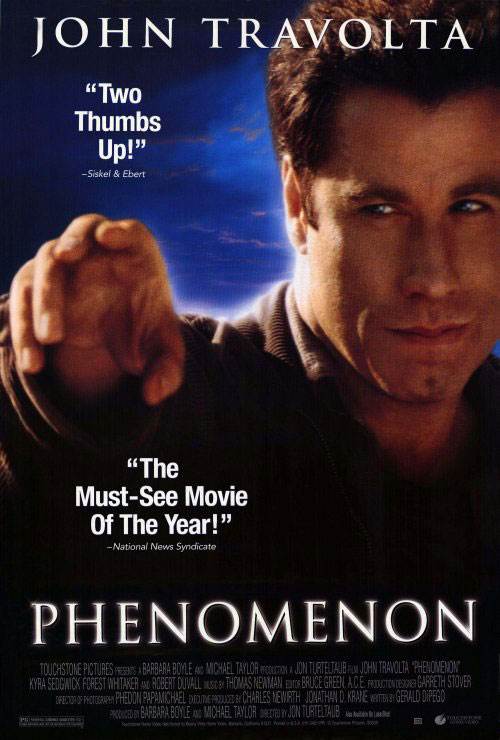
“Phenomenon” (1996) – Film Review

“Phenomenon” (1996), directed by Jon Turteltaub and starring John Travolta, is a film that strives to be a profound exploration of human potential and intelligence, but ends up tripping over its own ambitious feet. Marketed as a feel-good, quasi-scientific drama, it falls into the trap of over-sentimentality, leaving the viewer with a saccharine aftertaste rather than any meaningful insight.
Narrative: Intellectual Enlightenment or Hallmark Card?
The story follows George Malley (John Travolta), an everyman whose life is upended on his 37th birthday when he acquires phenomenal mental abilities, including telekinesis and super-intelligence, after witnessing a strange light in the sky. What unfolds is a narrative that teeters between a sincere exploration of what it means to be more than ordinary and a clumsy foray into quasi-mystical melodrama.
The film attempts to tackle themes of alienation due to intelligence, the human fear of the unknown, and the nature of love and acceptance. However, these themes are handled with all the subtlety of a daytime soap opera, leading to moments that are more eye-roll-inducing than eye-opening.
Performances: Travolta and the Cast’s Balancing Act
John Travolta’s performance as George Malley is one of earnest effort. He tries to infuse the character with a mix of wonder, confusion, and later, solemn acceptance of his fate. However, the performance often feels uneven, vacillating between genuine emotion and the kind of overacting that belongs in a superhero film, not a drama about intellectual awakening.
The supporting cast, including Kyra Sedgwick as Lace, the love interest, and Forest Whitaker as George’s best friend, Nate, provide solid performances. Yet, they are often relegated to mere reactors to George’s evolving condition, rather than fully fleshed-out characters in their own right.
Behind the Scenes: Crafting Phenomenon’s World
In creating the world of “Phenomenon,” the filmmakers embarked on a journey to visually and narratively balance the ordinary with the extraordinary. The cinematography, led by Phedon Papamichael, captures the small-town setting with a warmth and familiarity that contrasts sharply with the more fantastical elements of the story.
One of the challenges faced by the production was portraying George’s abilities in a way that was visually compelling but not overly fantastical. The use of special effects was deliberately restrained, a decision that helps keep the film grounded, even as its narrative veers into the unbelievable.
The Music: A Score That Tries Too Hard
The film’s score, composed by Thomas Newman, is an emotive, orchestral backdrop that aims to elevate the drama. However, like much of the film, the music often feels like it’s trying too hard to elicit an emotional response, resulting in a score that is more manipulative than moving.
Themes: Intelligence and Isolation
At its heart, “Phenomenon” is a film that grapples with the idea of intelligence as both a gift and a curse. The movie poses interesting questions about how intellectual enhancement could lead to isolation and fear, both from the individual and those around them. However, these themes are explored with a heavy hand, leaving little room for nuance or ambiguity.
Cultural Impact: A Forgettable Flick in the Pantheon of Sci-Fi Dramas
Since its release, “Phenomenon” has largely faded from the public consciousness, remembered more as a footnote in John Travolta’s career than as a significant entry in the genre of science fiction drama. It serves as a reminder that a compelling premise is not enough to make a film resonate; it requires a depth and finesse that “Phenomenon” ultimately lacks.
Final Thoughts
“Phenomenon” is a film that reaches for the stars but only manages to grasp the treetops. Its attempt to meld a small-town drama with elements of science fiction results in a movie that is neither here nor there. While it offers a few moments of genuine emotion, they are lost in a sea of clichés and heavy-handed messaging. The film is like a puzzle where the pieces are forced to fit, creating a picture that is coherent but ultimately unsatisfying.




